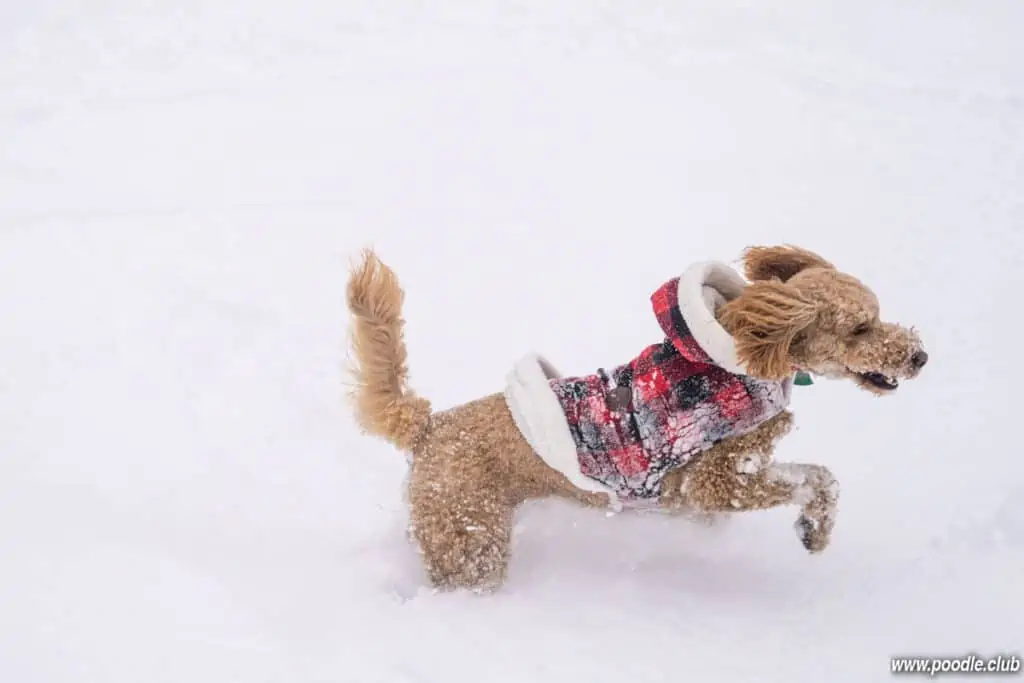Are Labradoodles Dangerous? Unveiling the Truth
Labradoodles, a popular crossbreed of Labrador Retrievers and Poodles, have gained a considerable amount of attention in recent years due to their charming looks and friendly nature.
As with any breed of dog, it is natural to wonder if these seemingly gentle and affectionate canines pose any sort of danger to humans or other animals.
In this article, we will explore the temperament, behavior, and potential risks associated with Labradoodles to determine if they are truly dangerous or just misunderstood.

As a breed, Labradoodles are known for their intelligence, playfulness, and highly social personalities. They are often easy to train, making them a popular choice for families looking for a loving and adaptable companion. However, as with any dog, a Labradoodle’s behavior may vary depending on various factors such as genetics, training, and socialization.
For this reason, it is important to look beyond stereotypes and evaluate each individual Labradoodle to make an informed decision about its potential as a family pet.
Key Takeaways
- Labradoodles are generally friendly, intelligent, and easy to train.
- Individual temperament and behavior may depend on factors such as genetics and socialization.
- A thorough understanding of each Labradoodle’s background will help determine its suitability as a family pet.
Behaviour and Temperament

Socialization Skills
Labradoodles are generally sociable and intelligent dogs that appreciate interacting with people and other animals. As with any breed, it’s important to socialize your Labradoodle from an early age. By exposing your dog to various people, environments, and situations (like dog parks, car rides, and walks in different areas), you’re helping them develop the confidence and social skills they need to become well-rounded, good-natured pets.
Training and Temperament
Being smart and outgoing, Labradoodles are usually easy to train, thanks to their eagerness to learn and enthusiasm to please their owners. They excel in obedience training and can thrive in dog sports like agility and flyball. Consistent, positive reinforcement-based training is essential to ensure that they develop a friendly demeanor and avoid displaying negative behaviours.
Labradoodles have a friendly and energetic temperament, making them excellent social dogs. Remember that keeping them physically and mentally stimulated through regular exercise and mental challenges is key to avoiding undesirable behaviours like fear, anxiety, or possessiveness.
Signs of Aggression
It is important to monitor your Labradoodle for any signs of aggression, which can manifest in various ways like:
- Growling
- Barking
- Possessive body language
- Snapping
Nipping these behaviours in the bud by redirecting your dog’s attention and introducing appropriate training techniques will help promote a well-mannered and non-aggressive pet. Observe their body language during social interactions, and if they display aggressive signs, seek advice from a professional trainer or behaviourist to address the issue properly.
Remember that a well-socialized, trained, and mentally stimulated Labradoodle is generally a friendly and sociable dog with a low likelihood of displaying aggressive behavior. By focusing on proper socialization, training, and understanding their body language, you can ensure a happy and well-behaved companion.
Health and Grooming Concerns

Potential Health Issues
Labradoodles, like any breed, may experience some health problems, but with responsible breeding, these risks can be minimized. Some common Labradoodle health issues include hip dysplasia, a condition that affects the hip joint and can lead to arthritis. Regular check-ups and weight management can help mitigate the impact of hip dysplasia on your dog.
Eye diseases such as progressive retinal atrophy, cataracts, and glaucoma can also affect Labradoodles. Regular veterinary eye examinations can help detect these issues early, ensuring that your dog receives proper care and treatment. Labradoodles are also prone to Addison’s disease, a hormonal disorder, and von Willebrand’s disease, a bleeding disorder.
PuppySpot is a reputable dog marketplace where you can browse and find compatible puppies right from the comfort of your home. They have placed over 200,000 puppies into homes in the US!
Both of these conditions require medical attention and can be managed with the help of your veterinarian.
Unethical breeding and inbreeding can increase the risk of health problems in Labradoodles. To avoid this, always choose a responsible and reputable breeder who prioritizes the health of their dogs.
Grooming Needs
Labradoodles are often considered a low-shedding and hypoallergenic breed, making them a popular choice for those with allergies. However, not all Labradoodles are entirely hypoallergenic, and shedding may vary between individual dogs. Regular grooming can help manage both shedding and matting in your Labradoodle’s coat.
To keep your Labradoodle’s coat healthy, consider the following grooming tips:
- Brushing: Brush your dog’s coat at least once a week to prevent matting and remove loose hair. This routine will help maintain a healthy coat and reduce shedding.
- Bathing: Bathe your Labradoodle every 4-6 weeks, using pet-friendly shampoo and conditioner to keep their skin and coat clean and moisturized.
- Ear Care: Labradoodles can be prone to ear infections, so cleaning their ears regularly is essential. Use a veterinarian-approved ear cleanser and gently clean the outer ear to prevent infections.
By being proactive in your Labradoodle’s grooming and healthcare, you can ensure they remain happy, healthy, and well-maintained for years to come.
Feeding and Exercise

Diet Requirements
It is essential to provide your Labradoodle with a balanced diet to prevent illness and maintain overall health. Make sure to feed them high-quality dog food that meets their nutritional needs. Some important components of a proper diet include:
- Protein: Labradoodles require a good amount of protein to support their energetic nature.
- Fats: A moderate amount of healthy fats is needed for energy and maintaining a healthy coat.
- Carbohydrates: Complex carbs are essential for sustained energy levels throughout the day.
If your Labradoodle experiences any pain or potential signs of injury, consult your veterinarian for guidance on adjusting their diet accordingly.
Exercise Needs
Giving your Labradoodle adequate exercise is crucial for their well-being. As an energetic breed, they require regular physical activity to prevent any behavioral issues arising from a lack of exercise. Consider the following guidelines for exercising your Labradoodle:
- Daily walks: Aim for at least 30 minutes of walking per day—this can be split into multiple sessions if needed.
- Playtime: Incorporate interactive games like fetch or tug-of-war to keep them engaged and entertained.
- Mental stimulation: Provide puzzle toys or engage in training sessions to challenge their mind as well as their body.
Be sure to monitor your Labradoodle for any signs of pain or discomfort during exercise and seek veterinary advice if needed. Properly balancing their diet and exercise routine will help ensure a healthy, happy life for your Labradoodle.
Labradoodle Origins and Controversy
When you delve into the history of the Labradoodle, you’ll find that it is a cross between the Labrador Retriever and the Standard Poodle. Wally Conron, an Australian breeder, created the breed in the 1980s with the intent of developing a hypoallergenic guide dog. His idea was to combine the intelligence, trainability, and low-shedding coat of the Poodle with the friendly, loyal, and hard-working nature of the Labrador Retriever.

However, you may notice that Labradoodles are not recognized by the American Kennel Club (AKC) as a breed standard. This is because Labradoodles, like other so-called “designer breeds,” are considered mixed breeds rather than purebred. Some critics argue that breeding Labradoodles potentially weakens the purebred lines of both parent breeds.
In response to the controversy, the Australian Labradoodle was developed by combining the original Labradoodles with other breeds such as the American and English Cocker Spaniel as well as the Irish Water Spaniel. The aim was to achieve a more uniform appearance and temperament within the breed.
Being a mixed breed, the appearance of Labradoodles can vary considerably. Some may resemble the curly-haired Poodle, while others may inherit the shorter coat of the Labrador Retriever. The combination of genetics from both breeds impacts not only the coat type but also the size, temperament, and overall health of the dogs.
Despite the debate surrounding their origin, Labradoodles have found a place as family pets and therapy dogs. Their friendly nature and trainability make them excellent companions for many individuals. It is important to remember that, like any breed of dog, Labradoodles can exhibit a range of behaviors and traits depending on their genetics, upbringing, and environment.
In conclusion, while the Labradoodle has faced its share of controversy, it continues to gain popularity thanks to its endearing qualities. As a prospective Labradoodle owner, it’s important to thoroughly research the breed and its specific needs to ensure you can provide the best possible home for your furry friend.
Raising a Labradoodle
When raising a Labradoodle, it’s essential to create a positive and safe environment for both your dog and your family members. These dogs are notoriously friendly and adaptable, making them an excellent choice for households with children. However, a few essential aspects must be addressed to ensure they grow into well-mannered and reliable companions.

Socialization: Introduce your Labradoodle to various people, animals, and environments from a young age. This process will help them become comfortable and confident around children, family members, and other pets.
Positive reinforcement: Using positive reinforcement, such as praise or treats, helps your Labradoodle understand what you expect from them. Avoid physical punishment, as it could lead to fear or aggression. Instead, focus on rewarding good behavior and providing consistent guidance.
Preventing neglect and abuse: Labradoodles thrive on human interaction and require regular exercise. Make sure to provide your dog with daily walks, playtime, and mental stimulation. Neglecting their needs can result in undesirable behavior or even health issues.
Adapting to your environment: Whether you live in a city apartment or a rural home, your Labradoodle should be able to adjust with ease. Ensure they have the appropriate space and resources to be comfortable, and be mindful of their specific needs in varying weather conditions.
Addressing potential issues: Be vigilant for any signs of physical abuse or emotional strain in your home. Encourage an open and supportive atmosphere where both your Labradoodle and family members feel safe and respected.
By following these guidelines, you’ll create a nurturing environment for your Labradoodle to grow into a cherished and reliable family companion.







